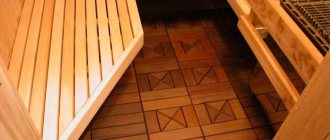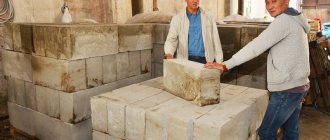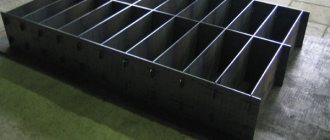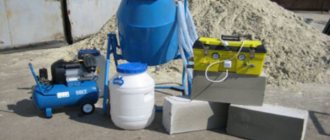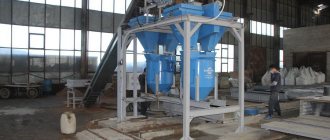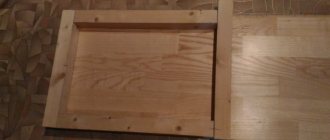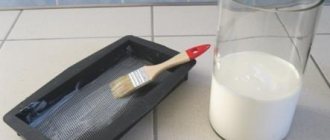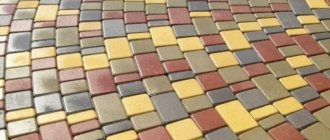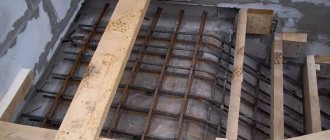In modern individual low-rise construction (buildings, retail space, warehouses, etc.) foam concrete is widely used. This is due to the low price and high performance characteristics of the material (low thermal conductivity, low weight, etc.). In many technical parameters it is better than brick and conventional concrete (reinforced concrete). In addition, foam concrete acts as insulation.
Thanks to the use of new technologies, manufacturers have managed to make this material accessible, because previously it was expensive. Therefore, today houses made of foam concrete can be found in any region of the Russian Federation.
Do-it-yourself foaming agent for foam concrete
Foaming agent composition:
- caustic soda (caustic soda) – 0.15 kg;
- rosin – 1 kg;
- wood glue – 0.06 kg.
The manufacturing technology is somewhat labor-intensive and time-consuming. Therefore, it is advisable only for significant volumes of work.
How to make a foaming agent for foam concrete at home
Preparation involves two stages:
- mixing the adhesive solution. To do this, pieces of dry glue are filled with water (1:10) and left for a day. During this time, the glue will swell a little, but will hold its shape. Therefore, the container with water and glue is heated to 60 ° C (with constant stirring). The adhesive solution is ready when all the pieces have dissolved and formed a homogeneous mass;
making rosin soap. For this purpose, the sodium is brought to a boil. Then rosin is gradually introduced into it. The boiling process will take about 2 hours until the rosin is completely dissolved.
Note. Rosin should be crushed first.
Both compositions are mixed when the rosin soap has cooled to 60 ° C.
Note. When mixing, rosin soap is poured into the adhesive solution. Mixing ratio 1:6.
The resulting mixture is poured into a foam generator and high-density foam is obtained. Foam with a density of 80 g/dm3 is considered optimal for use. Using less dense (more airy) foam will degrade the quality of the block and lead to its rapid destruction.
Note. You can check the quality of the foam by filling a bucket with it. After turning the bucket over, the foam should stay inside.
The production diagram of foam blocks is shown in the figure.
Foam block production diagram
Note that, like the first pancake, the first foam concrete blocks usually also come out lumpy. There are several reasons for this:
the difficulty of dosing the constituent components in the solution;
increased/decreased water content in the solution;
increased content of foaming agent in the solution. Its consumption should not exceed 1.5 liters. per 1 m/cub.
Unfortunately, such experiments not only prolong construction time, but lead to additional costs. However, as users testify, they are completely justified. Moreover, defective foam blocks can be used as backfill under the floor, and used equipment for the production of foam concrete can be sold.
Note. As practice shows, it is better to make structural foam blocks (grade D-900 and higher). They contain fewer pores compared to thermal insulation, and are easier for beginners to make.
Foam block production technology
Fill the concrete mixer with sand, Portland cement and water in the required proportions. The apparatus is started, after which it is expected that a homogeneous mixture will be obtained. Next, the foam is prepared in a foam generator, after which it is added to the mixture, and then the required amount of hardener is poured into the solution. Next, the solution is stirred again for 3–4 minutes. With longer mixing, the foam will collapse, and the strength and other characteristics of foam concrete will decrease.
After preparing the solution, it is filled into molds prepared in advance (wooden ones are moistened with water, and iron ones with machine oil or waste). After filling out the forms, the poured blocks are left to harden for a day (sometimes you have to wait longer). Concrete must gain strength at an air temperature of 6C or more. If work is carried out in a cold workshop in winter, then it must be warmed up using a heater or a heat gun. After a day, the finished foam blocks are removed from the molds and placed on pallets.
It should be borne in mind that the better the hardener used, the faster the foam blocks harden.
In general, the entire procedure for making foam blocks takes no more than 2 days. To competently organize the technological process and increase its productivity, the following is required:
- Use water heated to 30C to mix the solution.
- To accelerate the hardening of foam concrete, calcium chloride must be added to it (≈1.5% of the total mass of the mixture). In addition, this will reduce the likelihood of block cracking. The additive must be used when performing work in winter.
- If you regularly fill foam blocks, it is better to make steaming chambers for drying foam blocks at 60C. This will reduce the production time of products.
- Use forms with cells whose dimensions comply with GOST standards.
- Wood molds must be covered with polyethylene after filling, and iron molds must be lubricated with machine oil (working off) before use.
Pros and cons of using foam blocks
Foam blocks (photo).
Like any other building material, foam block has its own area of application, disadvantages and advantages.
Advantages
- Environmental friendliness. The material is non-toxic. Even at enormous temperatures (up to 1200 degrees), it does not emit harmful substances into the air;
- Durability;
- Fire resistance;
- Noise insulation. Walls made of foam blocks do not allow extraneous sounds to pass through well, and unlike brick, they do not allow low-frequency sounds to pass through;
- Manufacturability. The process is not expensive in terms of labor or electricity. For production and further use, the intervention of heavy construction equipment is not required;
- Economical. This material is one of the cheapest. For example: a cubic meter of brick costs about twice as much as a cubic meter of foam blocks.
Flaws
- On self-built walls made of foam blocks, cracks may appear as the building settles;
- Walls made of this material do not tolerate deformation, and it can only be used on strip foundations.
Equipment for the production of foam blocks requires special consideration.
What are foam blocks
Foam block is foam concrete, put into a certain shape. How to make a foam block? For this you will need:
- cement;
- sand;
- foaming agent;
- water;
- equipment for obtaining the mixture;
- forms.
To obtain 1 m³ of finished blocks you need approximately:
- 200 kg of construction sand;
- 320 kg of cement PC 500 DO or grade not lower than M 400;
- 1-1.5 l of foaming agent;
- hardener;
- water as needed;
- electricity.
Diagram of a homemade foam generator.
In terms of money, this comes out much cheaper than purchasing blocks in a store. The most expensive component is cement. Its cost is approximately 75% of the cost of all material received. Additionally, you need to spend money on special equipment. This includes:
- foam generator;
- concrete mixer;
- compressor;
- pressure gauges;
- forms.
Shapes are very important in making blocks. The sizes of the finished blocks depend on them. To build a bathhouse or garage, you can make foam blocks with your own hands measuring 50 x 20 x 20 cm. To build the walls of a house, it is better to make the blocks 30 cm wide. All equipment can be bought, rented, or made independently. Molds are quite easy to make from different sheet materials. It is better to use metal sheets. You need to make a large box and equip it with cells the size of future blocks. These sizes can be any.
Forms and partitions can be made from 10 mm thick plywood. In this case, it is recommended to line them with polyethylene so that the mixture material is not absorbed into the wood and the finished blocks are easily removed from the cells. There is no need for huge sizes; it is enough to have 40 cells in the form. If you have 2 such forms in your work, the process of making blocks and installing walls from them can be done simultaneously. Ready blocks.
Properties of foam concrete
Cellular concrete, or, as it is called, foam concrete, is a porous stone and is an excellent substitute for wood. It contains in its sealed cells - pores - the most effective heat insulator in the world - air. Cellular concrete is closer to wood than to stone, and brick is closer to stone; it is a heavy and cold material. Cellular concrete is environmentally friendly, and in this respect it is not only inferior to wood, but also has certain advantages, because wood is prone to rotting, fungus and all sorts of harmful things settle in it, but in stone or silicate material these harmful things do not settle.
Foam concrete has other advantages. It does not burn, is easy to process, and durable. Different brands of foam concrete can differ in density several times, which makes this material universal: it is suitable for external walls, for internal partitions, for heat and sound insulation of roofs and interfloor ceilings.
We believe that this is the most Russian material because it can be made from local raw materials. And as a result, you can make a square meter of wall warmer than a brick house, but 2-3 times cheaper
.
The resulting foam concrete products are not inferior in quality to traditional autoclaved cellular aerated concrete. Due to the simplicity of the technology and the equipment used (exclusion from the technological cycle of grinding raw materials in ball mills and autoclave processing), the cost of products is 1.5-2 times lower than the cost of the same products made from cellular aerated concrete.
Foam concrete produced using a new non-autoclave and non-steaming technology has: - high heat and noise protection qualities; - high fire resistance; - durable; - environmentally friendly (has a certificate from the Russian Ministry of Health for foaming agents); - meets European standards; - economical (a cubic meter of foam concrete in 2 - 2.5 times cheaper than similar volumes of brick or expanded clay concrete).
Foam concrete and aerated concrete - do not confuse
On the domestic building materials market today you can purchase two artificial, porous building materials - aerated concrete and foam concrete (according to GOST 25485-89 Cellular concrete. Technical conditions. ). They are similar in composition because they are made using cement, sand, water and a blowing agent. Thanks to the last component, the material obtains a porous structure.
But many do not understand the difference between these materials, because they have many similar parameters. The difference mainly lies in the manufacturing technology of these building materials.
When making aerated concrete, aluminum powder is added to a dry mixture of cement and sand, after which the mixture is mixed well. Next, water is added to it. After which the aluminum powder reacts with the cement, resulting in the release of hydrogen and AL oxides. Hydrogen fills the concrete mixture with bubbles, the structure of which becomes cellular (bubbles can be large - 3 mm or more or small - 1 mm or less).
With low quality material, it has a non-uniform structure in height, which is reflected in many of its parameters. High-quality aerated concrete has a uniform structure and improved characteristics.
What is needed to make foam concrete
To produce this building material you will need:
In order to obtain a homogeneous material, you will need to sift and sort the ingredients. Therefore, to obtain high-quality foam concrete, it is necessary to have a vibrating sieve. If a pressure unit is used in production, it is necessary to have a compressor. If technology without the use of a pressure unit is used for production, a concrete mixer will be needed. If foam concrete will be used for the production of foam blocks, it is necessary to purchase ready-made forms for them or make them yourself. If the foam concrete solution is planned to be poured using monolithic technology, you will need boards for installing the formwork. A foam generator for foam production. In technology using a foam generator, a foam concentrate will be required.
This is a special material with high stability in cement mortar. This quality allows you to transport the finished mass to the required distance without destroying the structure of the material. It can be purchased in the form of an industrial concentrate or made with your own hands. A complex such as a pressure unit will significantly facilitate the work and reduce the amount of equipment.
When using it, you do not need a foam generator; the ingredients are mixed in the built-in activator. This process is performed under high pressure, so when the solution is unloaded, the air pores swell even more and the mixture becomes more porous. Such equipment for foam concrete makes it possible to deliver mass to the site of construction work and at the same time produce material with density parameters up to 1200 kg/m3. Water, sand, cement. Gloves to protect hands and a mask for working with bulk materials.
What does foam concrete consist of?
Before you start doing something, you need to figure out what it is, what it consists of and what properties it has. Let's immediately understand the proportions in order to understand what ratios in the mass will be necessary:
- cement. Its brand should be no less than M400, if higher, then even better. The raw materials should not be old, having been in warehouses for more than a couple of months. Freshness is the key to strength. The calcium content should not exceed 80%. You will need 300 kilograms of this stuff. If there is no verified wholesale supplier, it is worth purchasing in bags. This is the only way you can check the production date and evaluate the quality,
- sand. Definitely river and fine-grained. If it is not possible to obtain one, crushed or sifted will do. The quartz content in it should not be less than 77%, and clay and silt should not exceed 3%. Otherwise, the end result may be a crumbling mess that you spent a lot of money on. You will need 500 kg of sand,
- actually a foaming agent. Making it yourself is fraught with harmful consequences, so I also recommend buying it from specialists,
- water. Without it, we cannot do any work at all. Purified, without additives or foreign elements. It will require 0.4 of the volume of cement, depending on how many blocks you want to pour.
It is quite possible to make your own foam concentrate. On the one hand, this is not so difficult, but I would buy such an important element from trusted manufacturing companies. It contains rosin, wood glue and caustic soda. Some experienced masons give exact proportions, but it is very rare to achieve an ideal condition, as in production.
In addition, you will need special equipment, which also does not have the simplest structure.
Automatic dosing system of raw materials for the production of foam concrete
Many foam concrete producers know how much time it takes to prepare and pour raw materials into a foam concrete production plant. For example, for 1 batch with V=1 cubic meter. you need to manually fill 6 bags of cement (300 kg), sift and fill 17 buckets of sand (270 kg), measure the required amount of water and foam. At best, this will take 10-15 minutes. Per shift with a productivity of 20 cubic meters. foam concrete takes 1.5-2 hours of wasted time, 3-4 people manually pour 6 tons of cement and 5 tons of sand. In addition, we must not forget the human factor: errors in calculating the number of bags of cement, buckets of sand, liters of water lead to incorrect dosage.
The result is low productivity, high cost, and unstable quality of the foam concrete mixture. Therefore, manufacturers are trying to mechanize the entire foam concrete production process.
The proposed automated dosing system is designed to control the entire complex of foam concrete production from the supply of raw materials to the unloading of the finished mixture.
Dosing system for foam concrete production
Main parts of the dosing system:
1. Weighing cement and sand dispenser on strain gauges. 2. Sand conveyor belt. 3. Cement feeding screw. 4. Cement big bag dispenser (or cement storage silo). 5. Water dispenser. 6. Foam dispenser.
Description of the foam concrete production process:
The operator selects a recipe for preparing foam concrete and starts the process of automated production of foam concrete:
- The auger is turned on and cement is fed from the big bag unloader (or silo) into the weighing dispenser. After gaining the required weight of cement, the auger turns off.
- The conveyor for supplying sand to the weighing dispenser is turned on. After the sand has gained weight, the conveyor turns off.
- Water is supplied by a pump to the mixer. After collecting a dose of water, the pump turns off.
- The mixer turns on, the hopper valve opens automatically and the cement and sand are unloaded.
- Foam is added to the mixer from a foam generator through a foam dispenser.
- After mixing the components, the foam concrete is unloaded into the molds.
Advantages of using a dosing system:
| The operator can adjust and set various recipes for the production of foam concrete, select doses of raw materials, monitor the recipe and consumption of materials, configure and monitor all process parameters. The installed program in the remote control allows you to display the entire process of automated foam concrete preparation on the operator panel in real time. The benefits of using an automated dosing system: - reduction in the cost of foam concrete production, - reduction in the preparation time of foam concrete, - reduction in the number of personnel, - increase in productivity, - production of high-quality products. |
Automatic cement and sand dispenser
| Dispenser device The dispenser consists of a frame on which the receiving hopper and control panel are suspended. The hopper is equipped with a surface vibrator and an electrically driven shutter. Weighing occurs using strain gauges. The data is displayed on the operator panel of the console.
|
Automation tools
| The control panel allows you to control the operation of the entire complex for preparing the foam concrete mixture: a weighing dispenser, a screw conveyor, a belt conveyor, a pump and water dispenser, a foam supply pump, a mixer, a vibrator for a station for unpacking cement in big bags or a cement silo. The operator's touch panel is used to set the doses of components necessary for preparing the foam concrete mixture, control and monitor the technological process of foam concrete production. |
- Setting doses for batches (amount of cement, sand, water, foam).
- Automatic collection of cement into the receiving hopper.
- Automatic collection of sand into the receiving hopper.
- Automatic supply of water to the mixer - installation for foam concrete.
- Automatic rotation of the mixer.
- Automatic unloading of cement and sand from the receiving bunker.
- Automatic foam collection into the mixer.
- Unloading the foam concrete mixture into the mold.
- Installation for the production of foam concrete
- Sand conveyor
- Cement big bag unpacking station with auger
Equipment for curing foam concrete blocks
When purchasing basic installations for the preparation of foam concrete, the organization of production as a whole does not end. So what else could you possibly need?
Heat and humidity chamber
Horizontal autoclave for holding blocks
As almost everyone already knows, foam concrete blocks come in autoclave and natural hardening. The first products are of the best quality, since they are aged in the most favorable conditions. Such pleasure costs a lot, and for small industries it is not advisable to purchase autoclaves, since almost all models have a large loading volume.
For this reason, foam blocks harden under natural conditions. If in the summer this takes about a day, then at sub-zero temperatures the mold turnover rate decreases sharply. Some people cover the formwork with industrial batting and polyethylene to preserve heat, while others go further and create a chamber for steaming.
Steaming chamber for foam concrete
Such a “room” is an isolated room inside the workshop, where a certain heat and humidity regime is maintained. For this, there are special steam generators that automate the entire process, doing all the work for you. Again, purchasing such equipment requires investment.
If there are no available funds yet, you can make a budget option:
- fence off part of the workshop with accessible, inexpensive material - for example, the same blocks, used bricks or corrugated sheets;
- install gas heating pipes into the chamber;
- Place buckets of water in the chamber.
During steaming, gas heating is turned on and the optimal mode is maintained, with a humidity of at least 65%. As they say - cheap and cheerful. But during certification, it is better to remain silent about this method of aging blocks.
Cutting equipment for foam concrete monolith
Foam concrete cutting machine
Equipment for cutting foam concrete comes in two types of action. Some complexes cut the monolith, as they say: without leaving the cash register - immediately after the blocks are unmolded. This is very convenient, since you only need to store the finished products and that’s it - no extra work steps.
The blocks are cut with special strings that are highly accurate. But they are also characterized by a short service life and high cost.
Automated cutting machine
Another type of cutting installation involves transferring a foam concrete monolith onto it and direct sawing, which occurs using circles. This type of equipment is more durable and economical to maintain, although it is not always convenient to use.
Cutting foam concrete
Which machine to choose depends on the production base. For example, they plan to build a workshop in advance for mobile equipment, since special rails and space are needed to move it. The stationary installation is universal and can be used even outdoors - the main thing is to ensure unhindered supply of the foam concrete monolith.
Foam generator
Using this piece of equipment, it is possible to convert the solution into foam. Builders with experience agree that it is better to buy it ready-made rather than do it yourself. A foam generator or porosizer for foam concrete is compiled using the following instructions:
- Prepare a large and airtight container. For example, it is quite possible to use a barrel.
- Water and a special substance are placed inside. Using the latter, foam will be obtained.
- Connecting the compressor to the bottom of the unit. You will need to make a special outlet hole at the top.
- It is convenient to regulate the supply of substances using a special valve.
- The outlet is connected via a tee. A second valve will also need to be installed on the air supply side.
- Drawings of equipment for the production of foam concrete contain two outlets. Each of them must have a valve. In this case, it will be possible to correctly regulate the supply of oxygen and fluid.
- According to the instructions, the mixture passes through the grates and then enters the compartment. Through the process it is possible to form foam. A special nozzle must also be installed at the outlet of the triple distributor. If the installation was done at home, then a muffler from the car is used in this capacity. A lattice or other porous material must first be introduced into its structure.
Molding foam blocks
Today injection molding and cutting molding are used.
The first method involves pouring foam concrete into cellular forms, which you buy or make yourself. Thanks to this, this method is considered the most accessible. In construction, foam blocks of different sizes are sometimes required, so you need to prepare forms with cells of the required sizes in advance. When cast blocks are removed from their molds, the edges are often damaged.
In the second case, a large formwork is filled with a liquid solution, which is removed after the solution has hardened. Next, a large piece of foam concrete is cut into small blocks using a special installation, which contains cutting strings, tapes or saws. This allows us to produce more even blocks of the required size, and they never chip.
The disadvantage of this method is cutting, since this is a rather complex and labor-intensive process that requires some experience.
Components of a foam generator
To ensure the operation of the unit, according to the technology, it must have a compressor, mixers for foam and concrete composition, an element for dispensing and pouring the solution into molds, as well as a pump for pumping the composition. These are the main elements that form the apparatus; in addition to them, there may be other mechanisms and elements.
To produce a large volume of construction raw materials, it is possible to construct a foam generator from a combination of devices of the same type.
The power and other performance characteristics of the unit must ensure continuous operation at each stage of the process. The simplest option involves assembling an installation based on three components: a foam generator, a concrete mixer and a compressor. Often such a unit is used to produce mortar directly at the time of construction for pouring structures.
Correlation of parts parameters
When assembling the unit, it is important to maintain the necessary ratio between some of its components. Taking into account the decrease in the diameter of the spiral when it is pulled out, it is necessary to ensure a difference between the diameters of the outer ring and the pipe of 12-15% (the diameter of the ring is larger), as well as a difference between the diameters of the ring inside and outside - 20%, in favor of the outer diameter
This difference provides optimal ratios for pipes with different parameters.
Foam concrete characteristics and properties
Foam concrete has some properties that can be considered its advantages over a number of other building materials:
High quality thermal insulation. Thanks to the air-filled cells, the material has high thermal resistance.
In winter, this quality saves heating costs by about 25%. Good fluidity, allowing easy and high-quality filling of molds. Reliability. Foam concrete is not affected by atmospheric factors and chemical influences. This is a practically ageless material that is as strong as stone, does not rot, and is not afraid of dampness. Excellent strength characteristics.
The density of foam concrete is 400-1400 kg/cm³, allowing it to withstand compressive loads in the range of 10-100 kg/cm³. This increased characteristic makes it possible to use this material in the construction of objects with a lower volumetric weight, which leads to an even greater increase in the thermal resistance of the walls. Unlike materials such as foam plastic and mineral wool, foam concrete does not lose its qualities over time. They only get better due to the long maturation of this material: after four months its strength increases by one and a half times, and after a couple of years - by more than two and a half times compared to month-old cellular concrete. Maintaining an optimal microclimate.
Foam concrete, reviews confirm this fact, is distinguished by good air permeability, allowing the walls to breathe. Environmentally friendly. It does not evaporate harmful substances, as it is made from natural raw materials. According to this indicator, foam concrete is second only to wood.
For example, the environmental friendliness index for brick is 10, for cellular concrete – 2; bricks – 10; wood – 1; expanded clay blocks - 20. Excellent sound insulator. The material absorbs sound well without reflecting it, especially low noise. Fire safety. The first degree of fire resistance allows a fifteen-centimeter foam concrete wall to protect the room from fire for four hours. The large sizes of the blocks ensure ease and speed of installation.
Easily processed with cutting tools. High efficiency. The accuracy of geometric dimensions makes it possible to place blocks on glue, avoiding cold bridges, which saves the cost of plastering and additional insulation. The lightness of the blocks allows you to save on the foundation and floors, and are easy to transport.
- Date: 03/01/2015 Comments: Rating: 44
A do-it-yourself foam concrete installation is made using a certain technology. The final product of foam concrete is a foam block, which consists of the following components:
- cement; water; sand; foaming agent.
Foam generator diagram.
Home-made foam concrete is cheaper than its factory-made counterpart. Cement is considered the most expensive component of foam concrete, so the cost of the final product depends on its choice.
DIY foam generator for foam concrete
Purchasing this module is the most expensive part of production.
The purpose is to convert the foaming agent into foam before feeding it into the solution.
The design of the foam generator consists of three components:
- feeding module. A foaming agent solution is poured into it. Any container can perform this function;
- converting module. The quintessence of the installation is foam conversion;
- dosing module. Provides the ability to supply foam to a solution of a given density (determined by the brand of foam block).
Diagram of a foam generator for the production of foam concrete
Diagram of the device of a foam generator for the production of foam concrete
To make a foam generator you will need: a metal pipe (2 blanks), a pump, hoses, valves. And also a welding machine. The components are listed in more detail in the specification that accompanies the drawing of the foam generator.
Assembling a foam generator for foam concrete (diagram-drawing)
Drawing of a foam generator for foam concrete
Making a foam generator
The specificity of the factory foam generator tube is that at first it has a narrow channel, which then widens. This technique allows you to increase the speed of passage of the emulsion through the tube. Then at the exit it will have the maximum possible speed.
Making a mixing chamber
Weld two pipes to one of the prepared pipes. Moreover, it is advisable to place one of them (through which air will be supplied) at the end. And weld the second one, intended for supplying the foaming emulsion, on the side (at an angle of 90°).
Both inlet pipes (end and side) are equipped with two valves:
shut-off (allowing you to shut off the flow of foam concentrate);
adjustable (allowing you to adjust the supply parameters, change the pressure, pressure, quantity, etc.).
In practice, after the mixture supply parameters have been adjusted, the control valves are not used.
Note. The diameter of the side pipe should be 15-20% larger than the diameter of the end pipe.
Making a foam cartridge
A pipe is welded to the second pipe blank. It is designed to release the finished mixture. It is advisable to equip the outlet pipe with a device in the form of a funnel to reduce the rate of exit of the mixture. A filter is placed in the blank. The purpose of which is to convert emulsion into foam. You can purchase a ready-made filter.
But its function can be performed with no less success by metal mesh (brushes) for cleaning dishes.
At the same time, spiral ones are not suitable, only wire ones. These meshes need to be compacted as tightly as possible along the entire length of the foam cartridge pipe. To prevent mesh particles from flying out along with the mixture, a “Ruff” is installed at the outlet of the pipe, inside of which a mesh washer is installed.
Connection of mixing chamber and foam cartridge
Next you need to connect the mixing chamber and the foam cartridge. Naturally, this must be done so that the welded pipes are placed at opposite ends. To ensure an increase in the speed of passage of the foam concrete mixture through the tube, you need to install a Laval nozzle or a jet washer between them. Replacing the nozzle with a jet will reduce the efficiency of the design by 30-40%, by reducing the speed of passage of the mixture through it. However, it is cheaper, easier to install and can be used as a temporary option. The installation location of the nozzle or jet is shown in the diagram.
Diagram of a foam generator for foam concrete using a washer jet
Size ratio of foam generator for foam concrete (depth and inlet diameter)
Size ratio of foam generator for foam concrete
Connecting the compressor to the end pipe of the mixing chamber
Any compressor that provides a pressure of 6 atm is suitable for operation. Using a compressor with a receiver, pressure reducing valve and pressure gauge will allow you to regulate the pressure.
Material prepared for the website www.moydomik.net
Connecting the foam concentrate container to the side pipe of the mixing chamber
The container is installed on the floor, a hose is attached to it, through which the foaming emulsion (foaming agent plus water) will be supplied to the mixer by moving through the side pipe. Installing a small pump (an ordinary household “trickle”) will allow for a more efficient supply of foaming agent to the foam generator. However, in order to save money, the supply can also be organized by gravity.
A foaming agent for foam concrete made in such a simple way will cost much less than a purchased one. And the resulting foam will be in no way inferior to the foam obtained from a factory generator.
Simple equipment for making foam blocks with your own hands
If you have suitable equipment for the production of foam blocks and purchase raw materials at competitive prices, there is a chance to achieve a high level of profitability. Moreover, financial investments in such production do not require huge amounts of money.
You need to carefully familiarize yourself with the production process of foam concrete blocks and competently approach the selection of equipment, and you will be able to launch the production of this popular building material.
What is needed for production
It is possible to produce foam concrete blocks, but this requires a set of equipment and various devices:
- Formwork for pouring foam concrete and forming blocks of specified sizes;
- Foam generator with appropriate technical parameters;
- Compressor;
- Concrete mixer with sufficient capacity.
The presence of such a kit brings excellent results to manufacturers - a typical shift is 3 cubic meters of foam concrete blocks. So a week of active and productive work, and there will be a ready supply of foam concrete blocks for building a load-bearing wall.
One of the important units included in the equipment for the production of foam blocks is a foam generator, which forms a foam solution, which then enters the formwork or molds. This unit is more profitable and easier to make yourself if you have the necessary components.
It is advisable to have a three-phase compressor, as it develops more power, but if there is none, standard electrical voltage will do.
A classic foam generator consists of:
- Made from a body made of fine metal mesh,
- Containers of the required volume,
- Hose set,
- Compressor.
Foam generator operation
Self-assembled equipment for the production of foam blocks in the form of a foam generator exists in order to mix the foaming agent with water and air, and then send the resulting mass through the cells of the metal mesh of the body into pre-prepared forms.
In the process of adjusting the quality of the foam, you need to constantly check its consistency, because the properties of the foam concrete block will depend on this. If the foam spreads too much, you need to make the necessary adjustments to the components or to the operation of the foam generator to prevent this process from happening, otherwise it will be difficult to achieve a geometrically correct foam block.
And even if the foam concrete block is made from loose foam, this product will collapse under minor mechanical loads.
The composition of the solution used to produce foam concrete must include high quality cement. There are different proportions for the production of foam concrete blocks, and they depend specifically on the brand of cement used and the density of the concrete. If the concrete has a density of 300-500 per square meter, a mixture without sand is allowed.
If the density reaches 600 kilograms per meter, the use of natural sand will be required. It will be better for the final product if the sand is pre-screened.
Features of the production of foam concrete blocks
All components must be placed in the mixer and the mixing process must begin, adding the starting materials one by one. Mixing begins with cement, water and sand, and then foam is added to the production process.
The final product will depend on the speed of mixing the starting materials. If you use a vertical mixer, the mixing process lasts 20 minutes, and if you use a barrel with blades, this procedure is reduced by 10 times.
The manufacturer will have to choose between formwork and forms - which will be more convenient for him, and for what purposes he will use foam concrete blocks. The option with formwork requires the use of cutting the mass that has not completely hardened into separate fragments of equal size.
It is necessary to have marks on the formwork or use other measures to cut foam concrete blocks evenly without significant errors.
When using metal or plywood forms, foam concrete is poured into them and you need to wait some time until the mixture hardens and a foam concrete block is formed.
To speed up the hardening process, you need to use various additives and rooms with suitable temperature conditions.
It will be much more convenient to remove frozen foam blocks if you provide a collapsible design of the forms. Then you can remove the product without damaging its surface.
DIY foam concrete installation. Design features
An installation for the production of foam concrete can be easily made at home. First you need to find out the principle of its operation. The foam generator is presented in the form of a device used in the production of foam, which is the basis for foam concrete. The unit is presented in the form of 3 modules responsible for its operation:
- foam concentrate and mixture transport modules (to produce foam);
- control element (providing automatic dosing).
Scheme of foam concrete production: 1 – container for foaming agent solution, 2 – service platform, 3 – compressor, 4 – foam generator, 5 – mixer, 6 – pressure hose, 7 – tiered molds.
The concrete solution enters the foam generator, where it is mixed with air (under pressure), forming foam concrete. The device in question can have a productivity of up to 500 l/min. The concrete mixer is an additional tool to the foam generator. The first element can be replaced with a regular spatula or another object that is used for manual mixing of mixtures. The concrete mixer is designed for mixing the components of the solution.
The last installation is made by hand, taking into account all the nuances of foam concrete production. Pre-select a brand of concrete, buy high-quality sand and a special mixture for foam. Blocks can be made at the stage of arranging the foundation of the house. Foam concrete is used for this. To ensure optimal material consumption, the following calculations are made in advance:
- The volume of the walls is obtained by multiplying their height, width and perimeter.
- The perimeter of the structure is calculated by summing the lengths of each side.
Equipment
From the entire variety of equipment, the main and most commonly used types can be distinguished:
- Foam generator;
- Concrete mixer;
- Compressor;
- Foam concrete mixer;
- Forms.
Foam generator
Foam generator.
The foam generator performs the function of producing foam, on the basis of which foam concrete will later be produced directly in any type of concrete mixer.
Structurally, it consists of:
- a lower tank serving for a mixture of water and foaming agent;
- upper tank for foam concentrate;
- control and inlet valves;
- inlet pipe that generates foam.
The device is connected to water (if there is no centralized water supply system, you can fill it in buckets), the upper tank is filled with a foaming agent (any kind, you can even make it homemade, sometimes manufacturing instructions are supplied with the device).
Next, the device is connected to a compressor, which creates pressure and foam begins to exit the pipe. With the help of outlet valves the porosity can be set.
Concrete mixer
Concrete mixer.
This is a device for forced mixing of ingredients (sand, water, crushed stone, cement) in order to prepare a homogeneous mixture ready for use.
Concrete mixers are divided into:
- Gravitational;
- With forced mixing of materials.
In a gravity mixer, the ingredients rotate in a drum, which is equipped with blades on the inside. When rotating, the materials collide with the blades, thereby mixing.
In a concrete mixer with forced mixing of materials, the components are located in a stationary drum. Blades mounted on a shaft rotate in the drum.
According to the installation method, concrete mixers are divided into:
- Stationary;
- Mobile.
Devices with a finished solution output of more than 660 liters are usually stationary. Up to 65 l are always mobile. From 330 l to 500, both mobile and stationary.
Depending on the nature of their work, concrete mixers can be either continuous or cyclic. In cyclic, loading occurs in portions, and in continuous, loading of materials and output of the mixture occurs constantly.
Foam concrete mixer
Foam concrete mixer.
Designed for the production of cellular concrete. Used for the manufacture of blocks using foam barotechnology.
Combines three functions:
- Performs mixing;
- Generates foam;
- Works as a pump to transport foam to the installation site.
Thus, this is the most complete unit for the production of foam concrete. It combines the functions of a foam generator, concrete mixer and compressor.
Equipment for the production of foam blocks at home
To produce foam concrete, the following equipment is required:
- Concrete mixer. It is permitted to use an installation for the production of cellular concrete for these purposes;
- Compressor. Necessary for pumping air into the steam generator and mixer;
- Foam generator. Allows you to prepare foam;
- Form. It is often made independently from wood or iron.
If you plan to make foam blocks year-round, you will need to additionally buy a steamer in addition to the equipment listed above. You can also assemble the installation yourself, but this will not save much money. Moreover, some elements may not fit together well, which will affect the quality of the foam blocks.
It is better to buy equipment as a set, which costs between 100,000 and 250,000 rubles. This installation will make it possible to produce 10-25 m3 of foam concrete per work shift.
When selecting equipment, you need to pay special attention to the power and characteristics of the electric drive. In addition, you need to consider the distance to which the finished solution can be supplied.
If you are building your own house and you need the equipment one-time, then it is better to rent it.
While using the equipment, it must be washed periodically.
Construction equipment for the production of foam concrete
To produce foam concrete yourself, you need reliable industrial equipment that will work for years and bring profit to the owners. Therefore, it is advisable to buy construction equipment for the production of foam concrete from machine-building enterprises, and not from “handicraftsmen” for one year of work. Yes, the price of industrial equipment is steep, but it is justified by the high productivity and excellent quality of the resulting foam concrete. But foam blocks are subsequently made from foam concrete. This means that the quality with which we produce foam concrete, the foam blocks will be of the same quality. And who needs low-quality blocks? No one!
The article Selecting equipment for the production of foam concrete and foam blocks will help you choose the right equipment.
Equipment for the production of foam concrete - composition
The equipment for the production of foam concrete includes:
| PLANT FOR FOAM CONCRETE PRODUCTION created on the basis of an industrial mixer (pneumatic blower) for concrete mixtures VB-06719 for preparing foam concrete mixtures and delivering it to the place of installation. USED FOR MONOLITHIC CONSTRUCTION price 380,000 rub. | |
| FOAM GENERATOR designed for continuous supply of foam to a foam concrete production plant. Foam is formed by supplying a foam solution and air to the foaming module. Assembled on an industrial vortex pump VK2/26 and equipped with a pressure gauge for control, taps, hoses for supplying foam to the installation. price 50,000 rub. | |
| THE COMPRESSOR is designed to supply compressed air to the foam generator for foam production and to the installation for dispensing foam concrete. | |
| CONTAINER FOR WATER designed for preparing and storing a foam solution by adding a foaming agent to water in the required proportion. They consist of one cubic container made of polyethylene. The outside has a metal sheathing. There are drain taps in the lower part and filler necks in the upper part. Installed on a wooden pallet. The container measures 1000 x 1200 x 1160 mm. Equipped with hoses for connecting to a foam generator and heating element for heating water. price 10,000 rub. |
The price of the set is RUB 515,000.
Equipment for the production of foam concrete - delivery, installation
Based on the quality of the equipment and many years of experience in manufacturing equipment for the production of foam concrete, company representatives will advise you on all issues of organizing the production of foam concrete blocks. They will tell you what additional equipment you need to use in your production.
Stroysnabzhenie LLC will provide the full range of services related to the order: delivery by vehicle, installation and commissioning of construction equipment, as well as its further maintenance. Will help train personnel to operate the equipment and study the technology of foam concrete production.
WE RECOMMEND TO PURCHASE:
Cutting equipment for the production of foam blocks
Selection of equipment and main features of the technology
It is very important to select high-quality equipment for production - for foam concrete it is not necessary to purchase a new line; very often you can find used installations that have been used very little, but at the same time their cost is much lower.
Purchasing used equipment in excellent condition will save up to half the cost
Pressure installation as an optimal solution for small production
For those who decide to purchase equipment and make cellular concrete themselves, the best option would be a pressure unit. This is the simplest set of equipment with which you can produce blocks or foam concrete for construction needs.
Due to the fact that there is no foam generator in the design, the system is much simpler, while its cost is significantly lower.
A number of undeniable advantages speak in favor of pressure settings:
- Using this equipment, it is possible to produce several types of products: blocks of various sizes and configurations, facing slabs for facades and walls, as well as a liquid mixture, which is excellent for filling voids between brickwork, as well as external insulation of walls and ceilings.
Thanks to the cellular structure, filling voids will require 3 times less cement than when using conventional mortars
- If you decide to produce cellular concrete for sale, then you should take into account that the average profitability is 59-60%, which allows you to cover the cost of equipment after just two months of work. This option is one of the most budget-friendly, but its efficiency is much higher than that of its analogues.
- You don’t need to waste time on complex training; the instructions for using pressure units are so simple that you can master all the features of operation and maintenance in just a couple of hours. There is no need for lengthy training and practice; the whole process is simplified as much as possible, which significantly increases work efficiency.
- The equipment allows you to reduce the number of workers required for maintenance. Unlike options with a foam generator, which must be supervised by a separate specialist, even one person can work with a pressure unit.
- The compact dimensions of the equipment allow production to be located in a small room. Installation takes from one and a half to four square meters. Some options are equipped with wheels, which makes them mobile when working on building insulation.
Wheels allow you to move equipment for the production of foam concrete very quickly without the use of forklifts and cranes
Let's look at the main characteristics of an average power bar installation:
| Equipment performance | 1.5 cubic meters at one o'clock |
| Working capacity size | From 250 to 300 liters |
| Installation weight | About 300 kg |
| Air pressure in the system during operation | 0.65 atmosphere |
| Ready solution supply range | Up to 20 m horizontally, up to 5 m vertically |
| Length of unloading hose included | 2.5 m |
| Required voltage | 380 Volt |
| Installation power | 3 kW/h |
Production technology
Equipment for the production of foam concrete has a very simple technological cycle.
As noted above, the product manufacturing process is extremely simple and consists of three main stages:
- It is necessary to pour water and a foaming agent into a container called a foam bar mixer; after 10-15 seconds of mixing, foam is formed, into which sand and cement are added in accordance with the recommendations of the installation manufacturer and in accordance with the desired brand of the finished product.
Foaming agent is the main component for creating the cellular structure of concrete
- After approximately 2 minutes of mixing all components using a compressor, pressure is created in the installation, under the influence of which a foam concrete mixture is formed in the container. The process takes about 30 seconds.
- The finished composition is fed under pressure through a discharge hose into special molds or into cavities or formwork. The whole process from start to finish takes 10-12 minutes.
The mold for making blocks is selected in accordance with the required dimensions
- If blocks are made, then unmolding can be done after 8-14 hours, the exact time depends on the temperature and humidity of the surrounding air. The products must be carefully removed and placed on pallets for further drying. At an optimal temperature of 20 degrees, foam blocks gain tempering strength in two days.
Important! Despite the fact that the products become quite durable after just 2 days, they gain maximum properties only after 4 weeks, which is when they can be used for any need.
Some craftsmen, having drawings of equipment for the production of foam concrete, can make it themselves, but if you do not have the appropriate education and skills, it is better to purchase a ready-made version


